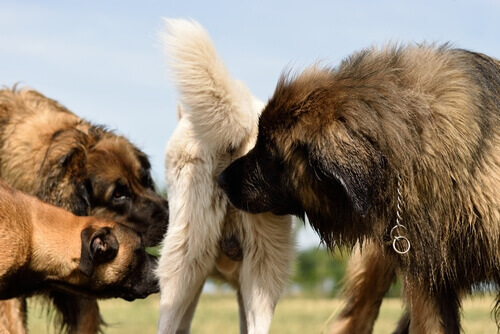The Use of Pheromones in the Animal Kingdom


Written and verified by the lawyer Francisco María García
A pheromone is a chemical substance that animals secrete to attract and communicate with another animal of the same species. Pheromones are perceived through sweat, urine, or saliva, whereas hormones are transmitted internally, through blood. In the article below, we’ll tell you more about the use of pheromones in the animal kingdom.
Contrary to popular belief, this chemical doesn’t only have to do only with the estrus cycle or fertility level. It also serves to alert animals of dangerous situations or territorial boundaries.
They’re also present in humans, although they don’t have the same potency as they do in animals. Their use in humans has only to do with sexual attraction, while in animals, they govern the species’ behavior.
Pheromones in the animal kingdom
In the animal kingdom, pheromones are practically a means of communication between species. The segregation of this substance allows animals to remain alert to the behavior or empathy of other specimens.

In some animals, such as cats, horses, or bulls, the pheromones that animals smell pass directly to this organ. Then, a behavior known as the Flehmen response occurs, which is when the animal raises its head and retracts its upper lip. This way, it allows the pheromones to dissipate in its saliva and reach the nasal passage.
Types of pheromones
These are classified according to their function and objective. In some cases, such as in ants, their use allows for tracking. At the same time, they use them to identify the surface in the exchange of food.
- Warning. They serve as a warning sign to other species. That’s to say, they announce the presence of a possible danger or risk for other animals.
- Marking territory. Through urine, many animals mark their territory or indicate which space is exclusive to them. This helps to indicate to other specimens the established limits i.e. that they shouldn’t make use of that area.
- Sexual. This is perhaps the use of pheromones among the animal kingdom that we know the most. They allow them to get to know which animals are in heat or in the period of reproduction. Through urine or sweat, males identify the females that are available for mating.

Uses of pheromones
In veterinary science, pheromones have been used in the manufacturing of products intended for animals. Some of them serve to calm anxiety, while others stimulate mating.
- As a calming agent. Synthetic pheromones are inspired by lactating pheromones and seek to calm puppy behavior. This is the case in bitches in the period of lactation, which secrete pheromones to reduce the anxiety of their babies.
- This type of substance has had good results in treatment for behavioral changes.
- As a sexual stimulant. Some animal breeders use synthetic pheromones to increase sexual desire. Although they still need to wait for the animals to go into heat, this stimulation benefits the male’s interest in the female. In other words, it guarantees that they’ll mount at the right time.
The use of pheromones has also been demonstrated in humans, although their effectiveness hasn’t yet been proven. Such is the case with perfume manufacturers, which have developed lotions with pheromone additives.
The effects of pheromones in sterilized animals
Castration is a practice that’s carried out directly on the animals’ hormones. It consists of removing the source of testosterone in males and estrogen and progesterone in females. This action can affect the production of pheromones.
In these cases, males will have an odor more similar to that of females. In theory, this odor modification can cause the male to arouse sexual desire in other specimens of the same sex. However, this doesn’t mean that they’ll lose their interest in mounting females in heat.
At the same time, castrated animals decrease their territorial demarcation. There’s no longer a need to mark the territory they possess. This way, the so-called territory pheromones will be reduced considerably.
This text is provided for informational purposes only and does not replace consultation with a professional. If in doubt, consult your specialist.